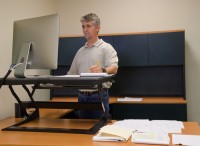How does emotional stress impact my back pain?
Emotional stress plays a very clear, however very complicated role in back pain, especially lower back pain.
For the purpose of this brief article we will try to provide a simple outline of how emotions (most commonly associated with the brain) can affect your body. I make note of one of my favourite books on the mind/ body connection and the role emotions can play on the fascia (connective tissue of the body).
Fascia or commonly referred to as connective tissue is integral to providing support and stability to our posture.
When we are physically challenged (fight or flight) our posture unconsciously braces to protect from physical danger. Our shoulders round forward to protect our chest and the vital organs, our head lowers in a braced position in behind our shoulder, our hips internally rotate to protect our reproductive organs, as we tense through our stomachs to prevent damage to the organs within our peritoneal cavity.
Whilst the above protective posture is really clear to see when we are physically challenged, how about how we look when we are emotionally challenged?
Let’s look at the extreme…. The posture of a broken man or women.
Head drops down, eyes pointing to the pavement. Shoulders drop down in state of despair, knees buckle with no spring in the step, with the hips rotated inwards, all visual signs of someone who is just in an emotional slump.
Whilst the above two examples are extremes of how the body protects and braces. It does give a very clear example of how your body can be affected by the state of your mind.
The human body is not designed to handle constant intermittent emotional stress. One of the side effects of emotional stress is physical tension that builds up and stays tight. If you suffer from emotional stress, having tension in these areas will be very familiar to you.
- Neck and shoulder tension – (shoulder round forward to protect, causing the neck and shoulder muscles and facia to restrict)
- Chest tension and difficulty breathing deeply – chest restricted from rounded shoulders, diagram tension that affects lungs filling with air.
- Stomach tension – shoulder and hips rounded forward causes the deep muscles of the trunk to shorten and contract.
- Lower back – due to the rounding forward of the hips, shoulders and the tension present deep in the stomach, diaphragm the fascia of lower back is under constant tension.
Some people have constant back pain due to their emotional state. Other people’s back pain only flares up when their emotional state boils over.
In short, whilst we don’t always noticeably crawl up into a ball when we have emotional stress we are struggling to cope with, we do have very noticeable tension present that causes us pain, back pain being one such area.
In essence your body is going into a protective mode whether you are aware of it or not, to brace and protect you from the emotional challenges you are faced with.
There are effective techniques to manage our emotional stress; a few that I recommend are:
- Sedeno method
- Demartini method
- The power of now.
On a more physical level you can help prevent tension building to the point where you are in days of pain, by strengthening your postural muscles.
If you feel strongly that your back pain is purely brought on by your emotional state and you want to understand the body/ mind connection to place together all the dots, I strongly recommend you read the book “Molecules of Emotions” by Candice Pert.
I will forewarn you.. If this subject is of interest to you, then you will not be able to put this powerful, thought provoking book down.
Here is a brief description of the book:
Why do we feel the way we feel? How do our thoughts and emotions affect our health? Are our bodies and minds distinct from each other or do they function together as part of an interconnected system? …
Candice Pert is the absolute authority on the mind/ body connection. A hard core scientist, whose life journey dove her deep into both the esoteric and science worlds. With the rare ability to quantify eastern medicine views with hard western science, some of her discoveries were simply remarkable.










